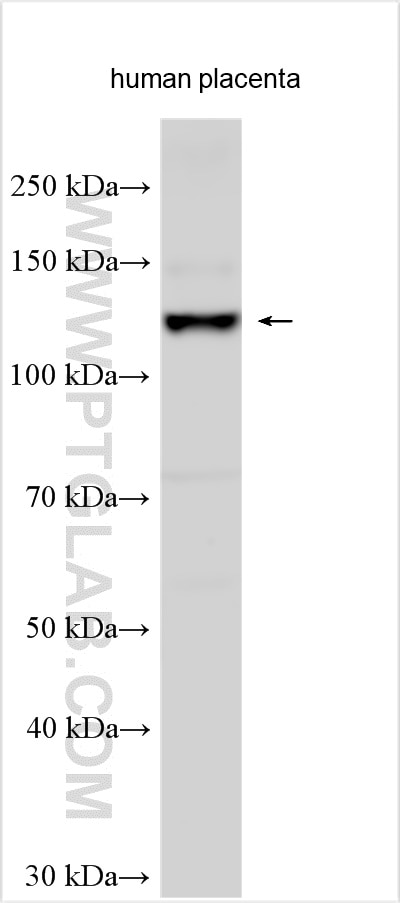Anticorps Polyclonal de lapin anti-TGFBR3
TGFBR3 Polyclonal Antibody for WB, ELISA
Hôte / Isotype
Lapin / IgG
Réactivité testée
Humain
Applications
WB, ELISA
Conjugaison
Non conjugué
N° de cat : 28992-1-AP
Synonymes
Galerie de données de validation
Applications testées
| Résultats positifs en WB | tissu placentaire humain, |
Dilution recommandée
| Application | Dilution |
|---|---|
| Western Blot (WB) | WB : 1:500-1:3000 |
| It is recommended that this reagent should be titrated in each testing system to obtain optimal results. | |
| Sample-dependent, check data in validation data gallery | |
Informations sur le produit
28992-1-AP cible TGFBR3 dans les applications de WB, ELISA et montre une réactivité avec des échantillons Humain
| Réactivité | Humain |
| Hôte / Isotype | Lapin / IgG |
| Clonalité | Polyclonal |
| Type | Anticorps |
| Immunogène | TGFBR3 Protéine recombinante Ag29397 |
| Nom complet | transforming growth factor, beta receptor III |
| Poids moléculaire observé | 130 kDa |
| Numéro d’acquisition GenBank | BC136295 |
| Symbole du gène | TGFBR3 |
| Identification du gène (NCBI) | 7049 |
| Conjugaison | Non conjugué |
| Forme | Liquide |
| Méthode de purification | Purification par affinité contre l'antigène |
| Tampon de stockage | PBS avec azoture de sodium à 0,02 % et glycérol à 50 % pH 7,3 |
| Conditions de stockage | Stocker à -20°C. Stable pendant un an après l'expédition. L'aliquotage n'est pas nécessaire pour le stockage à -20oC Les 20ul contiennent 0,1% de BSA. |
Informations générales
Transforming growth factor β (TGF-β) is a multifunctional cytokine that plays important roles in normal development and homeostasis (PMID: 8530052). There are three TGF-β forms: TGF-β1, TGF-β2, and TGF-β3. The diverse effects of TGF-β are mediated by the TGF-β receptors and cell surface-binding proteins. Three TGF-beta receptors exist: TGFBR1, TFGBR2, TGFBR3 (PMID: 8530052; 30184463). TGFBR3, also known as betaglycan, is a transmembrane proteoglycan that often functions as a co-receptor with other TGF-beta receptor superfamily members. In addition to the transmembrane form, the extracellular domain of TGFBR3 can be cleaved to a soluble form (sTGFBR3), which may serve as an antagonist of TGF-β to inhibit TGF-β signaling (PMID: 30184463). TGFBR3 has a larger apparent molecular weight than the calculated molecular weight, due to extensive carbohydrate modifications (PMID: 1556106).
Protocole
| Product Specific Protocols | |
|---|---|
| WB protocol for TGFBR3 antibody 28992-1-AP | Download protocol |
| Standard Protocols | |
|---|---|
| Click here to view our Standard Protocols |


